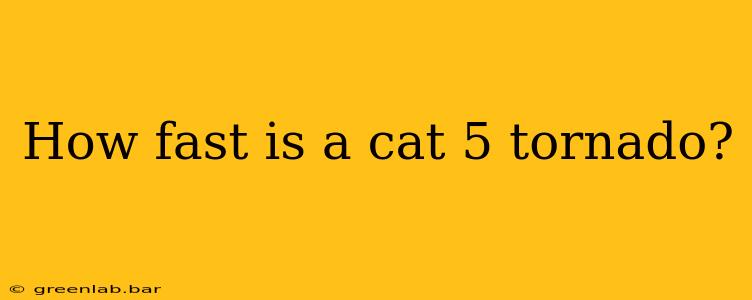The question "How fast is a Cat 5 tornado?" isn't as straightforward as it seems. While we use the Enhanced Fujita scale (EF-Scale) to categorize tornadoes based on damage, the wind speeds themselves aren't directly measured within the vortex. The EF-Scale, therefore, relies on observed damage to estimate the wind speed. This means there's a range of possible speeds associated with a Cat 5, or EF5, tornado.
Understanding the Enhanced Fujita Scale (EF-Scale)
The EF-Scale, introduced in 2007, replaced the older Fujita scale and provides a more precise way to classify tornadoes based on the damage they inflict. The scale ranges from EF0 (weakest) to EF5 (most violent). Each category corresponds to a range of estimated wind speeds.
- EF0: 65-85 mph (105-135 km/h) - Light damage
- EF1: 86-110 mph (140-175 km/h) - Moderate damage
- EF2: 111-135 mph (180-215 km/h) - Considerable damage
- EF3: 136-165 mph (220-265 km/h) - Severe damage
- EF4: 166-200 mph (270-320 km/h) - Devastating damage
- EF5: >200 mph (320 km/h) - Incredible damage
Wind Speed Estimates for EF5 Tornadoes
An EF5 tornado is defined by winds exceeding 200 mph (320 km/h). However, it's crucial to understand that this is an estimate. The actual wind speed within an EF5 tornado could be even higher. The difficulty in precisely measuring wind speeds inside a tornado stems from the intense, chaotic nature of these storms. Instruments capable of withstanding and accurately recording such high winds in the immediate vicinity of the vortex are incredibly challenging to deploy and maintain.
Factors Affecting Tornado Wind Speed
Several factors contribute to the variability in wind speeds within a tornado, making precise measurement a significant scientific challenge:
- Vortex Size and Shape: The size and shape of the tornado's vortex directly impact wind speed. Smaller, more intense vortices tend to have higher wind speeds.
- Atmospheric Conditions: Atmospheric pressure gradients, air temperature, and humidity all play a role in determining the intensity of a tornado.
- Terrain: The terrain over which a tornado travels can also affect wind speed and damage.
The Rarity of EF5 Tornadoes
It's important to note that EF5 tornadoes are extremely rare. They represent a tiny fraction of all tornadoes that occur. The destructive power of these storms underscores the importance of preparedness and timely warnings.
Conclusion: Understanding the Limits of Measurement
While the EF-Scale provides a valuable framework for classifying tornadoes, it's critical to remember that the wind speed estimates, especially for EF5 tornadoes, are based on observed damage, not direct measurements. The actual wind speeds within these incredibly powerful storms may be even higher than the estimated values. The inherent challenges in directly measuring wind speeds within a tornado highlight the ongoing need for research and improved forecasting methods.

